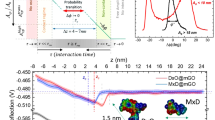Abstract
In the tapping-mode atomic force microscope (TM-AFM), the probe tip continuously taps the sample surface, which may cause plastic deformation of the sample and result in energy dissipation. The energy dissipation of the probe is closely related to the scanned phase image. To quantify the energy dissipation due to plastic indentations of the sample, this study utilized a combination of molecular dynamics (MD) simulations and experiments on single-crystal copper samples, including multiple nano-indentation tests. The energy dissipation of the probe due to the plastic deformation of the sample was calculated by integrating the hysteresis curve of the indentation depth versus the force applied to the indenter. The simulation results are in good agreement with the experimental ones. Both sets of results have demonstrated that the plastic energy dissipation decreases as the number of indentations increases, and eventually the energy of the probe tends to stabilize. This equilibrium energy dissipation is associated with other dissipation mechanisms. Furthermore, it was observed that, after hundreds of taps, the dissipated energy of plastic deformation could be ignored, implying that the scanned image may not reflect the plasticity information of the sample after multiple taps of the probe on the sample surface for scanning.








Similar content being viewed by others
Data Availability
Some or all data and models that support the findings of this study are available from the corresponding author upon reasonable request.
References
Giessibl FJ. Advances in atomic force microscopy. Rev Mod Phys. 2003;75(3):949–80.
Martinez NF, Garcia R. Measuring phase shifts and energy dissipation with amplitude modulation atomic force microscopy. Nanotechnology. 2006;17(7):167–72.
Garcia R, Gómez CJ, Martinez NF, Patil S, Dietz C, Magerle R. Identification of nanoscale dissipation processes by dynamic atomic force microscopy. Phys Rev Lett. 2006;97(1):016103.
Anczykowski B, Gotsmann B, Fuchs H, Cleveland J, Elings V. How to measure energy dissipation in dynamic mode atomic force microscopy. Appl Surf Sci. 1999;140(3–4):376–82.
Gomez CJ, Garcia R. Determination and simulation of nanoscale energy dissipation processes in amplitude modulation AFM. Ultramicroscopy. 2010;110(6):626–33.
Cleveland JP, Anczykowski B, Schmid AE, Elings VB. Energy dissipation in tapping-mode atomic force microscopy. Appl Phys Lett. 1998;72(20):2613–5.
Wei Z, Wang ZR, Sun Y, Xu XH. Dissipation energy in tapping-mode atomic force microscopes caused by liquid bridge. Chin Phys Lett. 2018;35(1):016802.
Wei Z, Liu J, Zheng XT, Sun Y, Wei RH. Influence of squeeze film damping on quality factor in tapping mode atomic force microscope. J Sound Vib. 2021;491:115720.
Deng W, Zhang GM, Murphy MF, Lilley F, Harvey DM, Burton DR. Analysis of dynamic cantilever behavior in tapping mode atomic force microscopy. Microsc Res Tech. 2015;78(10):935–46.
Klymenko O, Zuber JW, Lekka M, Kwiatek W. Energy dissipation in the AFM elasticity measurements. Acta Phys Pol A. 2009;115(2):548–51.
Gannepalli A, Mallapragada SK. Molecular dynamics studies of plastic deformation during silicon nanoindentation. Nanotechnology. 2001;12(3):250–7.
Paul W, Oliver D, Miyahara Y, Grütter PH. Minimum threshold for incipient plasticity in the atomic-scale nanoindentation of Au (111). Phys Rev Lett. 2013;110(13):135506.
Oliver D, Paul W, Ouali ME, Hagedorn T, Miyahara Y, Qi Y, Grütter P. One-to-one spatially matched experiment and atomistic simulations of nanometre-scale indentation. Nanotechnology. 2013;25(2):025701.
Ruestes CJ, Alhafez IA, Urbassek HM. Atomistic studies of nanoindentation-a review of recent advances. Crystals. 2017;7(10):293.
Wei Z, Peng AJ, Bin FJ, Chen YX, Guan R. Theoretical and experimental study of phase optimization of tapping mode atomic force microscope. Chin Phys B. 2022;31:076801.
Imboden M, Mohanty P. Dissipation in nanoelectromechanical systems. Phys Rep. 2014;534(3):89–146.
Gotsmann B, Anczykowski B, Seidel C, Fuchs H. Determination of tip–sample interaction forces from measured dynamic force spectroscopy curves. Appl Surf Sci. 1999;140(3):314–9.
Page TF, Hainsworth SV. Using nanoindentation techniques for the characterization of coated systems: a critique. Surf Coat Tech. 1993;61(1–3):201–8.
Mishin Y, Mehl MJ, Papaconstantopoulos DA, Voter AF, Kress JD. Structural stability and lattice defects in copper: ab initio, tight-binding, and embedded-atom calculations. Phys Rev B. 2001;63: 224106.
Stillinger FH, Weber TA. Computer simulation of local order in condensed phases of silicon. Phys Rev B. 1985;31(8):5262–71.
Promyoo R, Mounayri H, Varahramyan K. AFM-based nanoindentation process: a comparative study. Int Manuf Sci Eng Conf. 2012.
Yan W, Komvopoulos K. Three-dimensional molecular dynamics analysis of atomic-scale indentation. J Tribol. 1998;120(2):385–92.
Komvopoulos K, Yan W. Molecular dynamics simulation of single and repeated indentation. J Appl Phys. 1997;82(10):4823–30.
Sinnott SB, Heo SJ, Brenner DW, Harrison JA, Irving DL. Computer simulations of nanometer-scale indentation and friction, in: Bhushan B, Editor. Springer Handbook of Nanotechnology. Berlin, Heidelberg: Academic; 2017.
Wei Z, He MF, Zhao YP. The effects of roughness on adhesion hysteresis. J Adhes Sci Technol. 2010;24:1045–54.
Acknowledgements
This research was carried out with the support from the National Natural Science Foundation of China (NSFC 11572031).
Author information
Authors and Affiliations
Contributions
GL performed data collection, theoretical model proposal and validation, simulation, writing—original draft preparation, and revision. YZ and YC prepared experiments and discussion. ZW provided theoretical support, supervision, and funding acquisition.
Corresponding author
Ethics declarations
Competing interests
The authors declare no conflicts of interest.
Ethics Approval
The present paper fulfills the ethical responsibilities mandated by Acta Mechanica Solida Sinica.
Consent for Publication
The authors give their consent for publication.
Rights and permissions
Springer Nature or its licensor (e.g. a society or other partner) holds exclusive rights to this article under a publishing agreement with the author(s) or other rightsholder(s); author self-archiving of the accepted manuscript version of this article is solely governed by the terms of such publishing agreement and applicable law.
About this article
Cite this article
Liu, G., Zeng, Y., Chen, Y. et al. Exploring the Effect of Plasticity on the Phase Imaging of TM-AFM Through Molecular Dynamics Simulations. Acta Mech. Solida Sin. 37, 297–304 (2024). https://doi.org/10.1007/s10338-024-00468-6
Received:
Revised:
Accepted:
Published:
Issue Date:
DOI: https://doi.org/10.1007/s10338-024-00468-6




